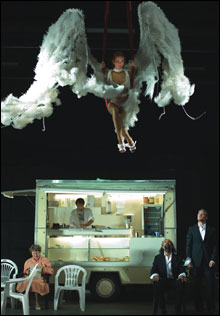
Wings of Desire |
Wim Wenders’s 1987 film Der Himmel über Berlin — Wings of Desire , as it’s known to us — had two defining characters that would seem impossible to re-create outside of the film itself. The first, and most crucial, is a divided Berlin — a Berlin that was destroyed when the Wall came down. And then there’s Peter Falk as himself, an angel who’s turned in his wings. So when ART associate artistic director Gideon Lester teamed up with members of the Netherlands-based Toneelgroep Amsterdam to adapt Wings of Desire for a stage production directed by the Syrian-born Ola Mafaalani, they had quite a challenge. As City of Angels , a 1998 film-to-film adaptation of Wings of Desire starring Nicolas Cage and Meg Ryan had already demonstrated, take away Berlin and Falk and what you’re left with is an ordinary love story. And that’s not at all what Lester or Mafaalani had in mind. Instead, as they explain, they went back to Wenders’s original screenplay and made some key discoveries — discoveries that made their adaptation possible.

“When you actually read the screenplay, there’s almost no mention of Berlin at all,” Lester points out. “Berlin exists in the cinematography but not in the language. So, the question for us was, if not Berlin, how do we realize the story now?”
The answer was fairly simple: “It’s set in the room with the audience right now on the stage. There are mentions of several cities, but it’s really anywhere. Plus, now we have Robin Young of Here and Now on the stage reading today’s news during every performance. So it really is set today, here and now.”
“And the next step,” Mafaalani adds, “was to figure out what did Wim Wenders want to say really? What he wanted to say was that angels could cross borders that humans couldn’t. When you read the screenplay closely, you realize that on both sides of the Wall people had exactly the same problems. What is it that holds you busy 24 hours a day? Politics? Social issues? I don’t think so. What holds you busy is, ‘Am I a good mother? Why did he leave me? I have to do my dishes. I have to do my washing. What is the sense of life? I’m afraid.’ These are still the real issues.”
And the Falk role? “You have to find a completely different way of approaching the story without Falk,” Lester admits. “If you think about that scene, the difference between using trick photography to have Peter Falk standing at an empty snack bar and saying, ‘I can’t see you but I know you are here,’ to two invisible angels, and having an actor saying to another actor, ‘I can’t see you but I know you’re here’ — the relationship for the people watching is totally different. It works because with film and stage you have two completely different vocabularies, totally different codes.”
For Mafaalani that meant asking herself, “What if I were Wim Wenders in 2006: what would I have done? Because Wenders is quite actual. And he wouldn’t have made a film about the Wall if there was no Wall.”
Or as Lester says, “It has to be a dialogue with Wenders and a reinvention of it. Often, in rehearsals, when we had a problem with the scene, we would go and look at the directions that Wenders was giving his cinematographer and his actors to see if there was any information there that wasn’t in the language of the screenplay. So Wenders was our Bible. But we had to both be faithful to it and smash it at the same time in order to be able to create it on stage.”